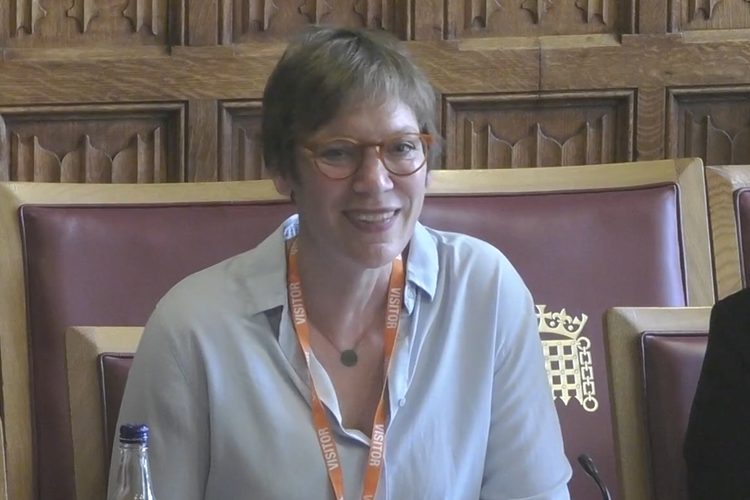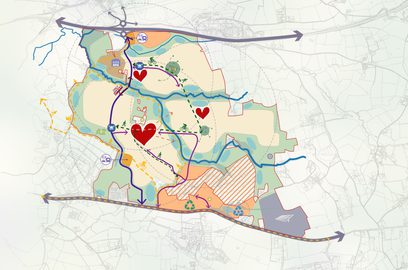How good masterplans can unlock the next generation of new towns

Tibbalds Director Katja Stille was invited to speak at the House of Lords a few weeks ago, giving advice on masterplanning new towns and communities. With 20+ years’ experience in this area, she sets out below the five key components that will make these new communities healthy, high quality and sustainable places to live.
I was fortunate to be invited to speak in June at the House of Lords on the future of New Towns – a key element of the government’s housing delivery agenda.
New Towns are an important part of addressing our housing shortage and provide the opportunity to create new large-scale, high-quality neighbourhoods fit for the future. Our world is very different from the post-war New Towns programme and has to reflect the need for greater diversity, density and sustainability.
Creating healthy and sustainable communities with quality and design ambitions is challenging, and delivering these plans won’t be quick. However, it is essential to enable our communities to live in healthy, affordable and sustainable environments – we need to rise to this challenge.
My key lessons learned, over 20+ years of experience in this area, and that I shared with the Built Environment Committee, are summarised below, organised around the theme of good masterplanning. They have been drawn together from working on three new settlements at different stages in the planning and development process: Otterpool Park Garden Community, Northstowe Healthy New Town and a New Settlement in East Devon that is currently seeking its name.
1. Flexibility and adaptability
From the start, there should be a spatial framework shaped around an engaging vision and agreed principles. Technical assessments and option evaluations must be robust to meet plan-making legislation and provide confidence. Throughout the long planning and delivery timescale many details will change or remain unknown in the early years. In the early stages we need a robust and commonly agreed vision and design principles that serve as long-term framework for decision making. These processes will better equip us to deal with uncertainty that our planning system struggles to accommodate.
For example, in the very early stages it is important to define a much wider red line – the ‘area of search’ or ‘Broad Development Location’. Its extent can be refined as plans move forward but having to re-consult or revise the original evidence base, because the line was drawn too specifically at the outset is time-consuming and costly. Likewise, from a masterplanning perspective, a balance is needed between fixed requirements around flood zones; environmental legislation and the setting of mandatory development principles to guide the future.
The Vision and Validate approach, which is gaining traction for transport strategies can be extended to other issues, so that we end up with a vision-led approach to planning and delivery rather than a constraint led approach.
2. Balancing short term viability pressures with long-term economic success
Strategic projects will be underpinned by a Business Case. Development decisions are made on today's values, costs and developer appetite. Measuring future towns on today's benchmark can stifle aspiration and undermine the opportunity for radical change. Evidence from today is not suitable to make decisions for 10+ years. For example, I believe that every new town or extended settlement must be linked by convenient and frequent public transport. However, delivering new rail services or light rail solutions is often seen as commercially unviable and not certain enough to support transport strategies for new settlements. By discounting what is important sustainable transport infrastructure from the outset we have already impacted the lives of future communities negatively. This is where strategic and regional planning is essential to build the case for public transport connectivity. Similar issues can exist around energy provision and the incorporation of renewable energy provision on site.
3. Housing diversity and density range
Good masterplans need to enable a variety of homes and characteristics. New Towns will require all types of homes to be delivered at pace to create a mixed community. They must accommodate that by creating different character areas – some of low density leading to the leafy suburbs of the future, and others of compact urban forms bringing vibrancy and walkability to the core of each town.
We need terraced housing, maisonettes and other urban housing types. In our recent research into medium density, we have called this the ‘missing middle’. Apart from creating choice, compact urban form with a range of house types, including urban family houses, such as terrace housing also integrates better into our existing environments, is more sustainable, more energy efficient, supports the economic case for public transport and creates healthier communities as it enables walking and cycling. A broader choice of homes will not only create better places, but it can also help deliver homes quicker and for a wider section of the community. Markets change and in a long build-out programme, developments can become more resilient to economic fluctuations if they are planned with greater variety in mind.
4. Phased delivery of facilities and mixed-use centres
A good partnership between the public and private sector requires a commercial approach where developer and housebuilder abilities and constraints are recognised. Commercial uses within the town centre will not happen until a substantial community has been established. Starting with parcels near existing public transport connections or areas of lower density are a much more viable proposition in the early phases, as are local centres and/or meanwhile uses.
The role of centres is likely to change over the life of the development. In the early phases it may well be best to locate a centre adjacent to an existing road to attract passing trade. However, in the long term it needs to serve the needs of the new community and be an accessible and high-quality place. This may conflict with the earlier need of attracting passing trade. This potential conflict needs to be resolved through good masterplanning, urban integration, appropriate phasing, mobility strategies and meanwhile uses.
As a reaction to communities being left without services, many Local Authorities have pledged a ‘centre first’ approach. Sometimes even a ‘town centre first’ approach. This can undermine the future viability of the centre. For example, phasing and practical construction considerations may lead to the centre being in the wrong location, on the periphery of the future community or it might be surrounded by low density housing as this is often more achievable in early development phases.
Therefore, the narrative should be changed to ‘facilities first’. This could be temporary and meanwhile uses or permanent uses within a small local centre. Good masterplanning, including phasing and delivery consideration from the outset, can help unlock these issues.
5. Ongoing oversight and governance
Setting strategic design principles around sustainability, health and wellbeing and embedding them in town or phase-wide strategies, as well as producing bespoke, practical design codes appropriate in detail and flexibility, can ensure quality of place throughout the delivery process.
Good governance must ensure coordination across all aspects of the town's delivery. We have come across examples where contracts with development partners either directly or indirectly undermine or even prevent the delivery of the vision. Often contracts are dealt with by lawyers and placemaking / design professionals are not consulted. However, these contracts determine what can and can’t be done and how much control the master developer, local authority or development corporation retains.
Design champions, who take on overarching responsibility for meeting the agreed vision and design principles, ensuring the golden threat from idea to reality isn't lost, is essential. They should become the go-to person for conflicts and resolving issues. Town specific design review panels that include community representatives further support the delivery of the vision. These will build up a level of expertise about the town and are familiar with its history.
There may be a perception that communities are initially unlikely to be in favour of new towns, but in our experience issues can be minimised when people see they are well-planned, have high levels of environmental sustainability and will genuinely provide services and infrastructure for new residents and the wider community. In fact, this is more likely in developments with critical mass that requires delivery of new schools and health centres, compared to smaller schemes that sit below thresholds for new amenities and receive similar local opposition.
It remains a paradox in our planning system that ambitious new communities must overcome more challenges than those with less aspiration and a business-as-usual approach. But providing future residents with a choice to live healthier, more sustainable, more socially-cohesive lives, is achievable and should not be negotiable – especially when these important considerations become the starting point for the masterplanning and delivery process.
You can watch the full committee on Parliament.TV: https://parliamentlive.tv/Even...
Related Updates

Marlcombe, East Devon selected as one of the New Towns

Tibbalds

Lizzie Le Mare attending LREF 2025

Tibbalds
Newham Council’s 50% affordable Carpenters Estate regeneration gets underway

Tibbalds
Stay In Touch
Sign up to our Newsletter
Subscribe to our newsletter to receive updates about making people friendly places.
